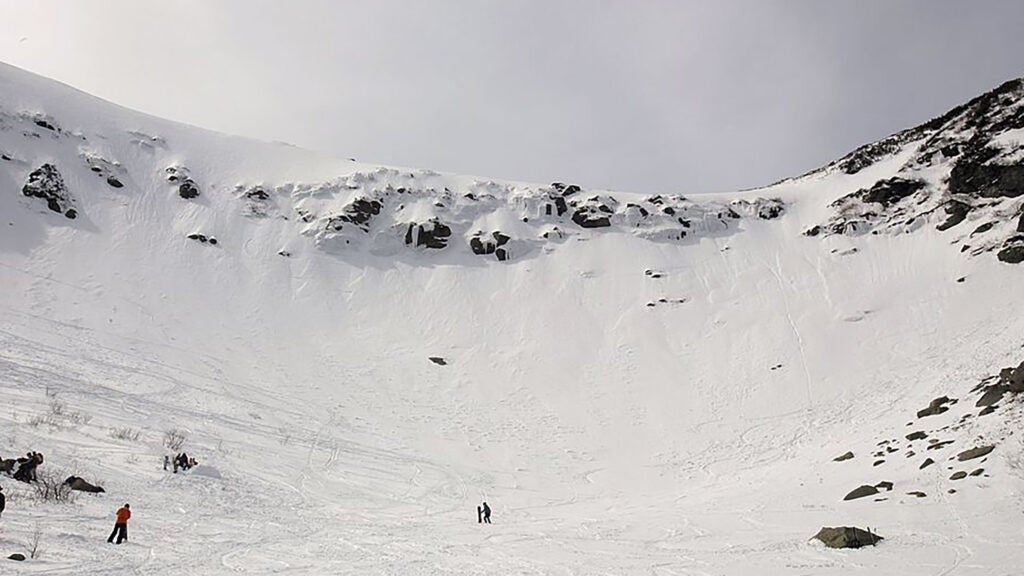No products in the cart.
Outdoor Adventure
A Skier Is Dead After Falling Down Tuckerman Ravine
Heading out the door? Read this article on the Outside app available now on iOS devices for members!
Download the app.
Tuckerman Ravine on the southeastern flank of Mount Washington holds an almost mythic reputation among expert backcountry skiers and snowboarders in New England. The glacial cirque sits mostly above timberline on the 6,288-foot peak, and the wide bowl boasts chutes and steep snowfields—extreme skiing terrain that is tough to find in the Northeast.
But Tuckerman is also dangerous, and reaching the summit requires a treacherous bootpack over ice or hardpack. A ring of boulders sits below the drop-in point, and the bowl is prone to avalanches, rockfall, and extreme weather that can alter snow conditions in a few hours. And this past weekend, the bowl was the site of a tragedy.
On Saturday, March 9, a 20-year-old backcountry skier named Madison Saltsburg fell 600 feet down Tuckerman Ravine and died of traumatic injuries, according to a release from the U.S. Forest Service. The fatal fall came on a day when two other skiers sustained serious injuries after falling in the same area. Those two skiers were saved by rescuers from the Mount Washington Avalanche Center, and the mission to save them stretched into Sunday morning.
The Forest Service statement reminded skiers to bring mountaineering tools like crampons and ice axes with them when recreating in Tuckerman Ravine. Officials attributed the falls to firm conditions in the bowl caused by a lack of recent snow and plummeting temperatures. “On March 9th, Saltsburg and her skiing companies were faced with hard, icy snow surfaces, open crevasse holes, and unforgiving conditions for a slip and fall,” the release said.
Broadcast outlet NBC10 Boston reported that Saltsburg was in her junior year at the University of Vermont at the time of her death.
It’s been a challenging winter for rescuers on Mount Washington. In December video circulated on YouTube of a skier triggering an avalanche in steep couloir called Airplane Gully—the skier sustained a broken leg in the fall and required a rescue via helicopter. In February, search and rescue personnel spent 11 hours saving 22-year-old Cole Matthew from the peak. Matthes had been attempting to reach the summit on a day when winds neared 100 miles per hour; he later fell into a ravine and began suffering from hypothermia. On March 4, video circulated on Instagram of a snowboarder tomahawking down Tuckerman Ravine. The man who shot the video, Evan Schwieger, wrote on the post that the snowboarder endured the dramatic fall without suffering major injuries. “I hope watching this video reminds people just how scary the bowl can be after one simple slip up,” Schwieger wrote.
Then, on March 7 a Kentucky man required lifesaving after he fell while descending a nearby wash called Ammonusuc Ravine. The man, 23-year-old Joabe Barbosa, suffered injuries to his head and face and also lost his shoe in the fall. He was suffering from hypothermia when rescuers reached him at 10:30 P.M. They gave him a headlamp, winter gear, and a warm drink before escorting him to safety.
In February, Outside spoke to Lieutenant James Kneeland of the New Hampshire Fish and Game Department, which oversees the state’s search and rescue operations, about the danger posed by Mount Washington in the winter. Kneeland mentioned the foul weather, gusting winds, and unpredictable snow conditions on the mountain. The most peak’s most deadly element, he said, is its close proximity to Boston and New York City. “Millions of people live within a short drive,” he said. “People want to test their ability and see what they’re made of, and it’s just right here.”

